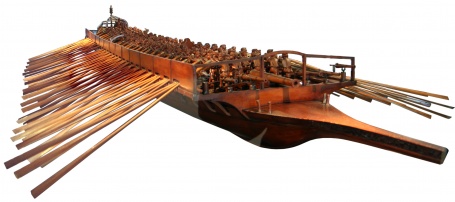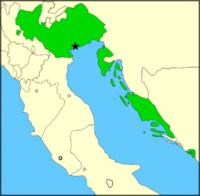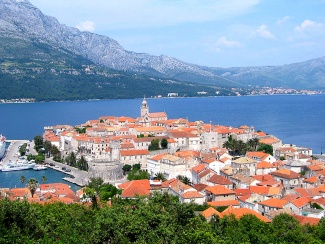Korcula History 2
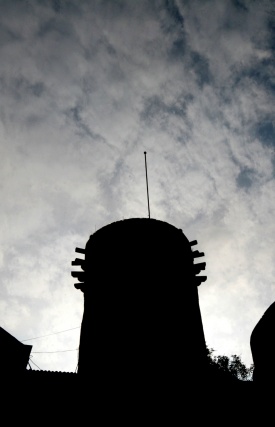
If we put aside political correctness, concerning Korcula's history
If we put aside political correctness, one could ask the question what happened to the Roman families when the Slavs invaded the island of Korčula? [1] The Slavic tribes invaded the Dalmatian province of the Byzantine Empire (Eastern Roman Empire).
Events
Events could have unfolded (Editor's theory) which led to the Roman families of Korčula (Corcyra Nigra) [2][3] being attacked and killed. The survivors could have fled from Korčula to Ragusa (Dubrovnik), then a place of refuge. Maybe some survived and remained on the island. Nikola Ostojic a 19th century Historian from Korčula describes the actual invasion of the Neretljani Slavs in his book "Historical Compendium of the Island of Korcula" which was written in 1858. The old Roman cities of Dalmatia; Epidaurum, Narona and Salona which were then part of the Byzantine-Eastern Roman Empire, were destroyed or just abandoned. This was due to the fact that the cities were not strategically set up for defence from constant invasions. According to various sources the Avars participated in these events too. The Avars were a nomadic people from Eurasian who invaded the Balkans at the same time as the Slavs. In this historic period it is recorded that many of the churches on the island of Korčula were abandoned (or destroyed) and then rebuilt at a later stage. [4] The Ostrogoths (a Germanic tribe related to the Goths) also invaded Dalmatia in the 6th century. According to Nikola Ostojic, the Roman families survived. They spoke the Latin Romance language - Dalmatian.
The new population of Slavs probably settled in the centre of the island and they spoke old Chakavian-Croatian. The centre of the island had its strategic qualities which allowed protection on all sides from attack by sea. It also had fertile land which allowed cultivation. After the invasion of Slavic tribes, the region stabilised to a certain extent. The Byzantines and the Republic of Venice and others,[5] started to exert a political influence over the region. These events have been recorded historically by both Empires in chronicles of the time.
Romanized Slavs
Dalmatians of Roman ancestry and the Republic of Venice brought Mediterranean cultural to the Slavs. Christianity was one aspect of this. In essence Slavs on the island were Romanized (adopted Latin culture). The 19th century theories concerning the identity of these early Slavs is flawed. The latest scholarly and archaeological research [6] states that the Slavs of Southern Dalmatian were identified as neither Croatians or Serbs. They were called Slavs.This term was first used by the Byzantines and was written in the 6th century in Byzantine Greek.
Later the Slavic peoples started to identify themselves and separated (or were separated by others) into different groups. It seems that in Southern Dalmatia the Slavic identity lasted much longer. As centuries went by Dalmatian Slavs started to referer to themselves as just Dalmatians.
Historic quote taken from Researches on the Danube and the Adriatic written by Andrew Archibald Paton in 1861. Chapter 4 - The Dalmatian Archipelago on page 164.
- Signor Arneri from the town of Korčula stated:
| “ | These three pears you see on the wall," said he, "are the arms of my family. Perussich was the name, when, in the earlier part of the fifteenth century, my ancestors built this palace; so that, you see, I am Dalmatian. All the family, fathers, sons, and brothers, used to serve in the fleets of the Republic (Editors notes: Republic of Venice); but the hero of our race was Arneri Perussich, whose statue you see there, who fought, bled, and died at the Siege of Candia,[7] whose memory was honoured by the Republic, and whose surviving family was liberally pensioned; so his name of our race. We became Arneri, and ceased to be Perussich [8] (Here is a perfect example of a Slavic family surname becoming later Venetian in character. According to Marinko Gjivoje, Perussich in modern Croatian is Piruzović.) [9] | ” |
There is archaeological evidence from 16th century where the Croatian identity was used. Stone writings in Zavalatica are dedicated to events from 889 AD. It describes a clash between the Slavic population and the Venetian army. Marinko Gjivoje wrote about the find in 1972. The stone writings use: Hrvat Dalmatinac in its writings. Hrvat means Croat in Croatian.[10]
Korcula Dialect
Korčula Dialect is a Croatian dialect from the island of Korčula in Croatia. The language base of the Korčula dialect is Chakavian Croatian (it is also intermixed with Shokavian). The Dalmatian remnants within the dialect have been referred to as Corzulot. Additionally it has influences of Venetian:
- Defora in old Venetian means "from the outside".
Regarding the Shokavian dialect below taken from-Land of 1000 Islands by Igor Rudan:
| “ | However, the clashes between the Ottoman Empire and Venetian Republic produced extensive migrations from the mainland areas, especially from today's Bosnia and Herzegovina, to the eastern parts of the islands of Brač, Hvar, Korčula, and Pag. The newcomers brought their gene pool and a variety of cultural specificities, including the “Shokavian” dialect of the Croatian language to the predominantly “Chakavian” area. The most extensive migrations to these islands occurred during the Cypriote (1571-1573), Candian (1645-1669), and Morean wars (1684-1699). The newcomers were given land and awarded special privileges “The Paštrović Privileges”. [11] | ” |
The new arrivals to the island were predominately Slavic Shokavian speakers. This must have put the Slavic speaks (Old Croatian Slavic - Chakavian + Slavic - Shokavian) on the island in a majority. Interesting today some Croatians and Serbs share this dialect. Venetian was still Lingua franca on the island and must have replaced Latin as the official written language.
Korcula dialect and Venetian
Template:Col-break- adio/ goodbye - Venetian: adio
- afitat/ rent - Venetian: afìt
- ala/ come on - Venetian: ala
- aria/ air - Venetian: aria
- arma/ armed - Venetian: arma
- baba/ grandmother - In Venetian it means nanny
- baleta/ bullet - Venetian: bal
- banda/ side - Venetian side & flank
- balun/football - Venetian: balón
- banak/ bench - Venetian: banca
- baraka/shed or shack - Venetian: baràca
- barba/ uncle - Venetian: barba
- barilo/ barrel - Venetian: barìla
- barka/ type of local boat - Venetian: bàrca
- bareta/ cap, hat - Venetian: bareta
- bat / a type of hammer - Venetian:batu, meaning to strike.
- bevanda/ wine with water- Venetian: bevànda "watery wine"
- beštimat/ swear - Venetian: bestiemàr
- bićerin/ small glass - Venetian: bicér "glass"
- bira/ beer-Venetian: bira
- biskot/ cookies - Venetian: biscot
- boca/ bottle - Venetian:boca
- bonaca/ the sea is dead calm - Venetian: bonàca
- bonbon/ sweet - Venetian: bonbon
- botun/ botton - Venetian: boton
- bova/ bouy - Venetian: bova
- Brigela/ local nickname - Venetian: brighela meaning joker
- britva/ knife- Venetian: britolada
- bura/ northern wind - Venetian: bora
- burin/ light northern wind - Venetian: borin
- buža/ hole - Venetian: bus or buxa
- čorav/ blind - Venetian: ciòro "blind person"
- Defora in old Venetian means "from the outside".
- faca/ face - Venetian: faca
- falso/ fake - Venetian: falso "liar"
- feral/ gas lamp - Venetian: feral "lamp"
- feta/ slice - Venetian: feta
- figura/ figure - Venetian: figura
- forma/ shape - Venetian: forma
- fabrika/ factory - Venetian: frabica "construction building"
- fumar/ chimney - Venetian: fuma "smoke"
- gusti/ enjoyment - Venetian: gusto "pleasurable"
- karoca/ small carriage - Venetian: carosa carriage
- kartun/ cardboard - Venetian: carton
- kasa/ case - Venetian: casa
- katrida/ chair - Venetian: carega
- klapa/an a cappella form [12] of music - Venetian: clapa "singing crowd"
- kužin/ cousin - Venetian:cuxìn
- licenca/ licence - Venetian: icenca
- lapis/ pencil - Venetian: apis
- lavadin/ washbasin - Venetian: lavandin
- Levant/ strong easterly wind - Venetian: Levantera
- Malandrin/ Local nickname. In Venetian it means: dishonest & crook
- Maragun/ wood worker - Venetian: Marangòn
- mezo/ in between - Venetian: mèzo "half"
- mudante/underwear - Venetian: mudande
- pandur/ policemen - Venetian: panduro
- papit/ this word is used when feeding a child/ (Venetian: papa-means baby food)
- par/ pair - Venetian: par
- perun/ fork - Venetian: pirón from Greek: pirouni
- piat/ plate, dish - Venetian: piat
- pikolo/ small, little - Venetian: picolo
- pirula/ pill - Venetian: pirola
- pistun/ piston - Venetian: piston
- pištol/ pistol - Venetian: pistola
- pitar/ pot - Venetian: pitar (vas, jar)
- pitura/ paint - Venetian: pitura (painting)
- portela/ boat hatch - Venetian: portela (hatch, door)
- šiloko/ local wind - Venetian: siròco
- šporko/ dirty - Venetian: spórco
- šufit/ attic or loft - Venetian: sofìta
Korcula dialect and Romance Dalmatian
- botilja/ bottle - Dalmatian: botaila
- botun/ button - Dalmatian: botaun
- dreto/ straight - Dalmatian: drat
- frigati/ to fry - Dalmatian: fregur
- kadena/ chain - Dalmatian: kataina
- kapula/ onion - Dalmatian: kapula
- katrida/ chair - Dalmatian: katraida
Historic classifies of Korcula
- The indigenous population of Korčula were Mesolithic and Neolithic peoples. Archaeological evidence has been found at Jakas Cave near the village of Zrnovo and on the west end of the island in a cave called Vela Spila. [14]
- The island was then settled by Illyrians. [15] It is believed that the Illyrians arrived in the Balkans approximately 1000 BC. [16]
- A Greek colony was founded on Korčula. [17] Greek colonists from Issa (Vis) formed a small colony on the island in the 4th or 3rd century B.C.
Note: Lumbarda Psephisma is a stone inscription which documented the event and was found on the island of Korčula.[18] The Greeks (from Issa/Vis) established a settlement on the basis of a prior agreement with the representatives of the local Illyrians who were Pil and his son Daz. A literary work from the 1st century AD "Periegesis Hellados" [19] mentions a second Greek Cnidian colony on the island of Nigra Kerkyra (Korčula).[20] According to Nikola Ostojic the Greeks named it Corcira Melaena meaning Black Corfu after their homeland and the dense woods on the island. It is not known what the Illyrians called the island.
- The island became part of the Roman province of Illyricum.[21] The Romans called the island Corcyra Nigra. After the Illyrian Wars, Roman migration followed and Roman citizens arrived on the island.[22] The Illyrian population immediately after the Illyrian Wars suffered greatly under the Romans. A large portion of the Illyrians were executed and sold off to slavery.[23] In 10 AD Illyricum was split into two provinces, Pannonia and Dalmatia.[24] Korčula became part of the ancient Roman province of Dalmatia.
- In the 6th century it came under the Eastern Roman Empire-Byzantine (by then the Greek families would have been Romanized).
- Migrations of the late 7th and 8th century, brought the Slavic peoples into the Dalmatian region. The Neretljani Slavs invaded the island and occupied it. The Old-Slavic term for Korčula was Krkar.
Note: The Narantani, who are referred to today mainly as Neretljani, were a nation of pirates. Firstly known as Arentanoi.[25] Modern scholarly research now puts the time of the invasion of the Slavic tribes in the region to be much later.[26] Archaeological evidence found in the old Roman city of Salon and in particularly the artefacts found at the Old Croatian grave sites [27] in Dalmatia (during recent excavations) seems to confirm this. Some historians have placed the arrival of Slavs (in larger groups) now to be more in the region of the 8th century. In Korčula's case a small group of Slavs (Chakavian speakers) might have settled on the island in 9th century.
- Conquered by the Republic of Venice under the management of the doge Pietro Orscolo from 999 to 1100. The Venetian called the island Curzola.
- Held by the Genoese from 1100 to 1129.
- Recaptured by Popone Zorzi, from the Republic of Venice and ruled from 1129 to 1180, from 1252 to 1254, and from 1258 until 1357.
- Statute of Korčula was drafted in 1214.
Note: The Statute itself [28] was probably written by Latin-Roman Dalmatian & Slavic nobility. Here is an Historic quote taken from "When Ethnicity Did not Matter in the Balkans" by John Van Antwerp Fine:
| “ | In 1262 the Venetian praised the Slavs and Latins on the island of Korcula for submitting to the prince Venice had sent. [29][30] | ” |
- Possessed on behalf of the king of Hungary from 1257 and with brief interruptions of the Genoese until 1418.
- Devoting itself of its own accord to the Republic of Venice in 1420.
- Korčula was devastated by the plague in 1529 and 1558.[31][32]
- Surrendered with the Republic of Venice to France in 1797. (It was occupied by the Russians for a year in 1808.)
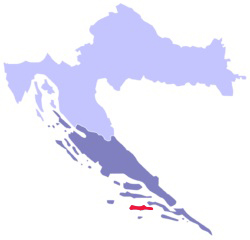
- British rule from 1813 to 1815 under the command of Peter Lowen.
- Occupied by Austria, first by obligation from 1797 to 1806, later by the Vienna Treaty from 1815 to 1918.
- Under the Treaty of Rapallo (Nov. 12, 1920 between Italy and Kingdom of Serbia, Croatia & Slovenia.),[33] Korčula became part of the Kingdom of Serbia, Croatia & Slovenia which was renamed Kingdom of Yugoslavia in 1929. After World War II Dalmatia was divided between three republics of Communist Yugoslavia. Most of the territory went to Croatia.
- In 1991 Korčula became part of the independent Republic of Croatia.
Additional:
- Venetian and Ragusan (Dubrovnik) families migrated to the island.
- Second Croatian (and other groups) migration in 17th and 18th century.
In this editors opinion to-days modern Korčula was originally a Roman town. It became a dual Latin Roman/Slavic town in the middle ages. With the arrival of Venetians in the 15th century it continued to evolve as such until the end of the Republic itself in 1797. Today we have surnames on the island that are not of Slavic origin, for example:
- Izmaeli - originally de Ismael
- Gabrijeliċ - originally Gabriel
- Đunio - originally de Giunio
- Bonguardo
- Depolo
- Sambrailo
- Jakov Baničević - originally Jacobus Bannissius
- Don Marko Bono of Žrnovo
- Vidali - surname of a noble family from the 16th century. [34]
Statement by Croatian Histotrian Sime Pericic:
| “ | It is true, then a small colony of Italians where in Sibenik, on the island of Korcula, Hvar and Vis, and other places of the province.[35] | ” |
In the 19th century the island became heavily influenced by Pan-Slavism and the Croatian Nationalistic movement. Pan-Slavism was later in the 20th century reinforced by the Yugoslavian governments. This had a strong influence on the historical development of the island of Korčula.
In 1918 Korcula was part of Austro-Hungarian Empire
In 1918 Korčula was part of the Kingdom of Dalmatia. Dalmatia was a province in the Austro-Hungarian Empire and was already more than a century old. As stated before, Dalmatia itself as a region, dates back to the Roman Empire which was well before the Slavic invasions of the early middle ages. According to the Austrian censuses the coastal region was predominately made up of Croatians and Italians (and other minorities).[36] With the disintegration of the Austro-Hungarian Empire in 1918, Serbia started occupying the region (Italy did the same). It was interpreted back then as the formation of the Kingdom of Serbia, Croatia & Slovenia.
The new kingdom had the support of Great Britain and France, who were the superpowers of the day. In retrospect this was a tragic move, one that the United States was against. The effects of this political stupidity are still felt today. It is interesting how this newly created state “Kingdom of Serbia, Croatia & Slovenia”, which later became better know as the ill fated Yugoslavia, was given a lot of support over the succeeding decades. This part of European history surely needs more academic attention.
Former Yugoslavia and History
The region of the former Yugoslavia (Western Balkans) has problems when interpreting its multicultural, multiethnic history and societies. This most certainly applies to the history of Dalmatia, the former Republic of Ragusa and other regions. The statement below comes from a book called Dalmatia (History, Culture, Art Heritage) written by Antun Travirka:
| “ | By the 14th century the city had become wholly Croatian [37] | ” |
The book itself is primarily for the tourist market and is easily available in several languages. This quote is on page 137 and it’s referring to the Republic of Ragusa. The old Republic of Ragusa (with it's famous city Dubrovnik) [38][39][40] is now within the borders of the modern Croatia. This monolithic description is an outright lie and it’s a form of cultural genocide (the crucial word is wholly). Additionally the book did not even use the term Republic of Ragusa (the closest that it got to this was RESPUBLICA RAGUSINA on page 141),[41] which was used for more than a millennium. The Republic was set up by Latin/Illyrian families and was a nation in its own right. It was also made up of many ethnic nationalities.[42][43][44][45] As a Maritime nation it traded all over the Mediterranean and even had trade with the Americas. Additionally it was in competition with Venice, the most powerful and influential maritime nation during that era.
- Statement made by the contemporary historian John Van Antwerp Fine:
| “ | This is not surprising since the “Ragusans” identified themselves as Ragusans and not as Croats.[46] | ” |
The former Communist Yugoslavia (which Croatia was part of) played a major role during the Cold War era in depicting this style of historical documentation (Dalmatia - History, Culture, Art Heritage) of the region’s past. Yugoslav Communist history is now dogma in Croatia. This also would apply to the history of the Dalmatian Italians. Many of today’s Croatians live with this dogma as their reality even though the Berlin Wall fell in 1989. The Communist Party of Yugoslavia had a profound effect on the region.[47] So much so that it has created today’s political and cultural scene.
- Statement made by the contemporary historian Danijel Dzino:
| “ | Medieval studies in Croatia and in most of the former Yugoslav space were firmly rooted in political history and suffered from isolationism and lack of interest in foreign scholarship. In the communist era, especially after the 1960s, Marxist ideology and national and Yugoslav political-ideological frameworks strongly impacted on the research into medieval history in Croatia [48] | ” |
- Statements made by the contemporary historian John Van Antwerp Fine (Professor Emeritus of History at the University of Michigan):
| “ | Such substitutions of “Croat” for” Slav,” however, mislead the reader into believing something the sources do not tell...[49]
|
” |
The nature of the regime that created this history:
- Quote from the European Public Hearing on “Crimes Committed by Totalitarian Regimes":
| “ | Mystifying the crimes of the occupiers, Titoism covered its own crimes. The taboo to hide the crimes of Titoism was meant to conceal the War-time and post-War murders of civilians and prisoners of war without trials. Their graves were levelled and in Slovenia it was forbidden to talk about their fate. Repressive organs controlled the burials sites and the living were strictly forbidden to mention the victims or the graves. The so-called system of preserving and developing revolutionary heritage was used by the Communist Party to implement a monopoly on the truth. [51][52] | ” |
Note: Communist Yugoslavia executed Historian - Kerubin Segvic. He was executed mainly for proposing a different historic model than that of Yugoslav regime state policies of Croatians arriving in the Western Balkans.[53]
See also
- Korcula History (Historical Compendium of the Island of Korcula)
- Korcula Dialect
- Titoism and Totalitarianism
- Dalmatian Italians
References
- ^ In Croatian the c in Korcula is pronounced ch and is written "č".
- ^ ""Korcula." Encyclopædia Britannica. Encyclopædia Britannica Online. Encyclopædia Britannica, 2011. Tue. 8 Mar. 2011." (2011). Retrieved on 2011-03-8.
- Encyclopædia Britannica: "Korčula, Italian Curzola, Greek Corcyra Melaina, island in the Adriatic Sea, on the Dalmatian coast, in Croatia. With an area of 107 square miles (276 square km), it has a hilly interior rising to 1,863 feet (568 m). The Greeks colonized it in the 4th century bc. Korčula was subsequently occupied by the Romans, Goths, Slavs, Byzantines, and Genoese; the kings of Hungary and Croatia"
- ^ Encyclopaedia Britannica (publ. 1911):
- "CURZOLA (Serbo-Croatian Korcula or Karkar), an island in the Adriatic Sea, forming part of Dalmatia, Austria; and lying west of the Sabioncello promontory, from which it is divided by a strait less than 2 M. wide. Its length is about 25 m.; its average breadth, 4 m. Curzola (Korcula), the capital and principal port, is a fortified town on the east coast, and occupies a rocky foreland almost surrounded by the sea."
- ^ According to recent studies done at the University of Zadar, Slavs on the island of Korčula accepted Christianity fully in the 14th century. Reference from: University of Zadar-Sociogeographic Transformation of the Western Part of Korcula Island by Lena Mirosevic-2008 (p161)
- ^ Neretljani Slavs (Narantani or Arentanoi )
- ^ Some of the latest research studies:
- Becoming Slav, Becoming Croat: Identity Transformations in Post-Roman and and Early Medieval Dalmatia by Danijel Dzino
- When Ethnicity did not Matter in the Balkans by John Van Antwerp Fine.
- Venice and the Slavs: The Discovery of Dalmatia in the Age of Enlightenment by Larry Wolff.
- ^ The Siege of Candia (modern Heraklion-Crete) was a military conflict in which Ottoman forces besieged the Venetian ruled city and were victorious. Lasting from 1648 to 1669, it is conceded by some to be the longest siege in history.
- ^ Researches on the Danube and the Adriatic: By Andrew Archibald Paton. Chapter 4. The Dalmatian Archipelago. (p164)
- Andrew Archibald Paton (1811-1874) was a British diplomat and writer from the 19th century.
- ^ Otok Korčula (2nd edition) by Marinko Gjivoje, Zagreb 1969.
- The book outlines A-Z about the island of Korcula, from traditions, history, culture to wildlife, politics & geography. (p46-p47): Piruzović
- ^ History-Korcula.net Marko Marelic-S. Francisco-USA
- ^ The Land of 1000 Islands by Igor Rudan
- ^ The traditional Klapa was composed of up to a dozen male singers (in recent times there are female Klape groups). Klapa singing dates back centuries. The arrival of the Croatians to Dalmatia and their subsequent settlement in the area, began the process of the cultural mixing of Slavic culture with that of the traditions of the Roman-Latin population of Dalmatia. This process was most evident in the coastal and island regions of Dalmatia. In the 19th century a standard form of Klapa singing emerged. Church music heavily influences the arrangements of this music giving it the musical form that exists today.
- ^ Venetian-English English-Venetian: When in Venice Do as the Venetians by Lodovico Pizzati (p19)
- ^ University of Zagreb: Faculty of Philosophy
- Some of the finds from Vela Spila (Big Cave) are on display at the University of Zagreb and the Center for Culture in Vela Luka.
- ^ The Cambridge Ancient History Vol. 11 : The High Empire, AD 70-192 by Peter Rathbone
- ^ The Illyrians (The Peoples of Europe) by John Wilkes,ISBN 0631198075-1996
- ^ An Inventory of Archaic and Classical Poleis: An Investigation Conducted by The Copenhagen Polis Centre for the Danish National Research Foundation by Mogens Herman Hansen,2005,Index
- ^ Hrcak Portal of scientific journals of Croatia: Lumbarda Psephisma, the Oldest Document about the Division of Land Parcels in Croatia from the Beginning of the 4th or 3rd Century BC by Miljenko Solaric & Nikola Solaic (University of Zagreb).
- ^ Swedish University- Essays Swedish (www.dissertations.se): Researcher, Traveller, Narrator. Studies in Pausanias' Periegesis-University Dissertation from Almqvist & Wiksell International Stockholm Sweden.
- ^ Studi sulla grecità di occidente by Lorenzo Braccesi (p68)
- ^ Encyclopedia Britannica.
- The Roman province of Illyricum stretched from the Drilon River (the Drin, in modern Albania) in the south to Istria (modem Slovenia and Croatia)
- ^ Croatian Adriatic: History, Culture, Art & Natural beauties
- ^ Historical Compendium of the Island of Korcula by Nikola Ostojic (p6)
- ^ John Everett-Healu. "Dalmatia." Concise Dictionary of World Place-Names. Oxford University Press. 2005. Encyclopedia.com
- ^ The Age of the Dromon: The Byzantine Navy ca. 500-1204 by John H. Pryor, Elizabeth & Jeffreys (p67)
- ^ Becoming Slav, Becoming Croat: Identity Transformations in Post-Roman and Early Medieval Dalmatia by Danijel Dzino (p212).
- Danijel Dzino states that the 19 century theories of mass movements of people into the old Roman Province of Dalmatia are questionable. Modern Archaeological and Scholarly research seems to be saying that we are looking at much smaller groups of Slavs and Avars invading the region. The term Slav was first used by the Byzantines and was written in the 6th century in Greek (Σκλαβῖνοι-Sklabenoi). Later in Latin it was written Sclaveni. According to Danijel Dzino the term Slavs was first used by outside observers of the day to describe the newcomers. The Slavs used the term to describe themselves at a later stage. Thus began the construct identity of the new arrivals. Later the Slavic peoples started to identify themselves and separated (or were separated by others) into different groups.
- ^ Becoming Slav, Becoming Croat: Identity Transformations in Post-Roman and Early Medieval Dalmatia by Danijel Dzino (p52).
- ^ Korcula Info (www.korculainfo.com): Korcula Town Statute from 1214
- ^ When Ethnicity Did not Matter in the Balkans: by John Van Antwerp Fine. (p103)
- ^ Smiciklas, CD V, (p237); N. Klaic, Povijest Hrvata u Razvijenom, (p130)
- ^ ""Korcula." Encyclopædia Britannica. Encyclopædia Britannica Online. Encyclopædia Britannica, 2011. Tue. 8 Mar. 2011." (2011). Retrieved on 2011-03-8.
- Encyclopædia Britannica: " A plague devastated the town in 1529, depleting the population. The burned houses of infected persons, called kućišta..."
- ^ The Shores of the Adriatic (Illustrated Edition) by F Hamilton Jackson (p239)
- ^ Encyclopedia Britannica-Dalmatia:
- Finally, the Treaty of Rapallo (Nov. 12, 1920) between Italy and Yugoslavia gave all Dalmatia to the Yugoslavs except the mainland Zadar (Zara) enclave and the coastal islands of Cres, Losinj (Lussino), and Lastovo.
- ^ Korčula City and Island by Alena Fazinić, Stanka Kraljević & Milan Babić
- ^ Concerning the Number of Italians/Pro-Italians in Dalmatia in the XIXth Century by Šime Peričić
- ^ Other minorities being: Serbs, Montenegrins, Albanians & Jews
- ^ Dalmatia (History, Culture, Art Heritage) by Antun Travirka (p137)
- ^ ""Dubrovnik." Encyclopædia Britannica. Encyclopædia Britannica Online. Encyclopædia Britannica, 2011. Web. 08 Mar. 2011." (2011). Retrieved on 2011-03-8.
- ^ ""Croatia." Encyclopædia Britannica. Encyclopædia Britannica Online. Encyclopædia Britannica, 2011. Web. 09 Mar. 2011." (2011). Retrieved on 2011-03-8.
- ^ Encyclopaedia Britannica (publ. 1911):
- ^ Dalmatia (History, Culture, Art Heritage) by Antun Travirka (p141)
- ^ Jews, Christians, and Muslims in the Mediterranean World after 1492 By Alisa Meyuhas Ginio (p190)
- ^ The Chicago Jewish forum, Volume 23 by Benjamin Weintroub (p271)
- ^ Footprint Croatia by Jane Foster (p271)
- ^ Croatia by Michael Schuman (p82)
- ^ When Ethnicity did not Matter in the Balkans: by John Van Antwerp Fine (p157)
- ^ The Fragmentation of Yugoslavia: Nationalism and War in the Balkans by Aleksandar Pavkovic.(p 47)
- The former Yugoslavia's political and cultural scene were heavily influenced by the cult of personality of the Dictator Josip Broz Tito.
- ^ Becoming Slav, Becoming Croat: Identity Transformations in Post-Roman and Early Medieval Dalmatia by Danijel Dzino (p43)
- ^ When Ethnicity did not Matter in the Balkans: by John Van Antwerp Fine (p11)
- ^ When Ethnicity did not Matter in the Balkans by John Van Antwerp Fine (p15)
- ^ European Public Hearing on “Crimes Committed by Totalitarian Regimes" (p201)
- ^ European EU's press releases concerning European Public Hearing on: “Crimes Committed by Totalitarian Regime-Brussels"
- ^ Becoming Slav, Becoming Croat: Identity Transformations in Post-Roman and Early Medieval Dalmatia by Danijel Dzino (p20)
External links
- Photo link for a aerial view of Korcula Town
- Korcula Info
- Vela Luka-Mediterano
- Wikipedia: Battle of Curzola
- University of Zadar (Sveučilište u Zadru-Universitas Studiorum Jadertina)
- University of Zagreb (Sveučilište u Zagrebu)
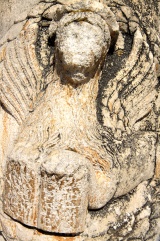
<sharethis />
Croatia Dubrovnik Neretva County Korčula Dalmatia Dalmatian Language Korcula History Korčula Dalmatian Venetian

